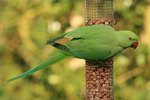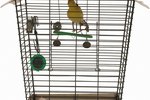
Small, boldly patterned zebra finches are among the most bred finch species in captivity and one of the best species for beginning bird owners. They have a sound all their own and are much quieter than some of the non-finch pet bird species. Ideal for people who don't have a lot of time for one-on-one interaction, zebra finches will thrive in a decently sized cage with little attention other than fresh food, water and a regular cage cleaning.
Description
The small zebra finch only reaches about 4 1/2 inches long, lending to their manageability. Both males and females have similar coloring: gray bodies with lighter gray heads and black markings on the cheek and other areas. The males, however, have bright orange cheek patches and black-and-white stripes, bands and markings on their throat, wings and tail. In most cases, the beak also varies between sexes, with the male possessing a red beak as opposed to the female's orange beak. While this is standard, a few different variations of the species have been bred to suit different tastes. Coloring may vary between these variations.
Behavior
Unlike other pet bird species that are known for talking, whistling or their song, zebra finches make a different sound that some people adore. Their typical song is a low, nasal chirp, and they're eager to chat with each other throughout the day. Males perform more high-pitched calls and songs than females. Zebra finches breed easily and freely in captivity, so same-sex pairs will prevent this from happening. Same-sex pairs of finches have been known to form loving, monogamous bonds just as male-female pairs. In the wild, these small finches live in large groups with a distinct hierarchy; groups of finches will also show their preference for a maintained hierarchy.
Cage
Because zebra finches aren't particularly affectionate or interactive with their people, they spend almost their entire lives in a cage. At a minimum, a 16-by-12-by-16-inch cage will suit a pair of these small birds. Within the cage you should set up at least two perches, but leave enough room between the perches for your finches to fly. They are social birds, however, so a small colony would be happier in a larger cage. Zebra finches sleep in nests; offer them either an open nesting box or a pre-made cavity nest. If you choose to have a small colony, a cage measuring 20-by-20-by-60 inches will be suitable for two or three pairs of zebra finches.
Diet
Like other finches, zebra finches have a diet consisting primarily of seeds. Several high-quality, prepared seed mixes are available at pet-supply stores and other retailers. These seed mixes typically consist of various types of millet and a plain canary seed. In addition to a high-quality seed mix, feed them fresh veggies, such as broccoli, and grit, a type of sand that aids in a finch's ability to grind its food.
References
Resources
Photo Credits
-
PhotoObjects.net/PhotoObjects.net/Getty Images
Writer Bio
With a professional background in gardening, landscapes, pests and natural ecosystems, Jasey Kelly has been sharing her knowledge through writing since 2009 and has served as an expert writer in these fields. Kelly's background also includes childcare, and animal rescue and care.




